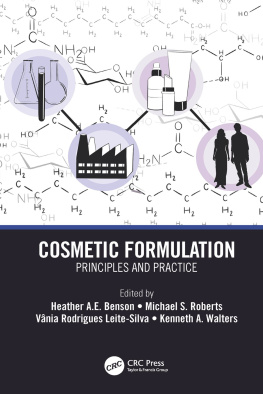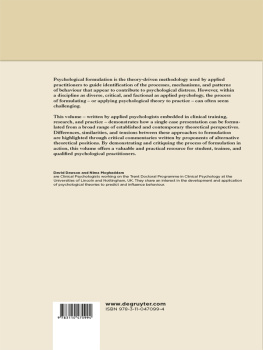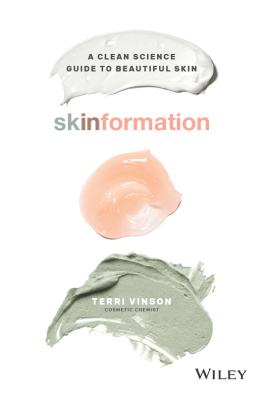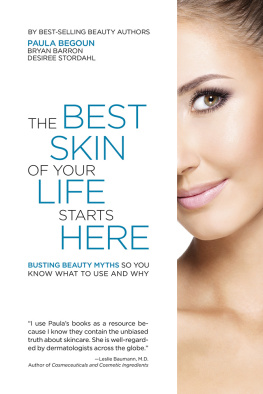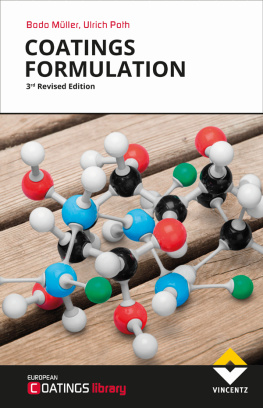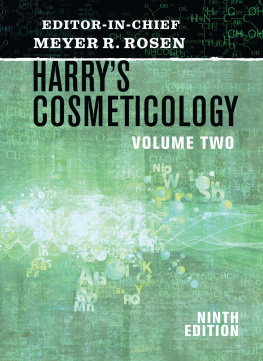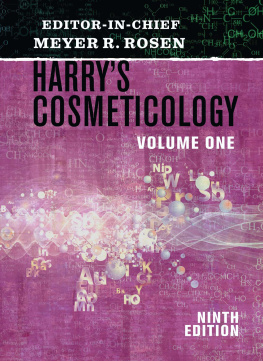Cosmetic Formulation
Principles and Practice
To the inspirational women in my life: my daughter Victoria, my sister Elaine, and my mum Anne.
Heather A.E. Benson
A special thanks to our parents, family, colleagues, staff, students and those who have gone before us. Each of them has helped us in a different but special way.
Michael S. Roberts
I would like to dedicate this book to my mother Celina and father Dan, for all their love and for always and strongly believing in me. They always say: From our small city Miracatu to the world.
To my husband Nelson and my kids Laura, Bruna and David: You are my inspiration, my love, my everything.
Vnia Rodrigues Leite-Silva
For my grandchildren, Joe, Abbie, Lily, Elsa and Roscoe. Tomorrows scientists?
Kenneth A. Walters
The nature of beauty is one of the most enduring and controversial themes in Western philosophy, and iswith the nature of artone of the two fundamental issues in philosophical aesthetics.
Crispin Sartwell
So what is beauty? Is it really in the eye of the beholder (subjective) or is it a fundamental attribute of an object or an act (objective)? Philosophers from Plato and Aristotle to Hume and Kant, together with many other great minds have considered this without resolve. Whatever the outcome of this philosophical argument, there is little doubt that within our species, beauty attracts attention.
Youre beautiful. Youre beautiful.
Youre beautiful its true
I saw your face in a crowded place
And I dont know what to do.
James Blunt
With this in mind it is, perhaps, not surprising that the importance of and the desire to enhance our image of beauty occupies a significant amount of cost, time and effort during our daily routines. In essence, we all want to look good to others and to ourselves. While in most cases this can be achieved simply by dressing smartly, presenting a clean faade and smiling, there are often occasions when some extra help is needed.
Makeup is no different than clothes and accessoriesits embellishments for your face. And it also gives you creative freedom. You get to have that moment in front of the mirror every morning and give yourself self-love. You're making yourself up beautiful, which is essentially self-love.
Michelle Phan
This was recognised many centuries ago by the ancient Egyptians. The use of scented oils and ointments was a common means of disguising body odour, and various metallic ores were used to alter face colouring. Thus, the use of materials to alter external body characteristics can be traced to around 10,000 BC. There have been a few improving developments over the past 12 millennia, for example, we can now eliminate body odour rather than simply mask it. We can now alter the colour of our hair and teeth using chemicals, which are relatively safe if used correctly. We can now apply various chemicals to our skin, which will reduce the risks associated with radiation damage and insect-borne disease vectors.
Cosmetics and cosmetic science have evolved over many years. In the time of Elizabeth I, it was the fashion to whiten the face and bosom using ceruse, a mixture of white lead and vinegar, to create this appearance. As Hamlet said to Ophelia God has given you one face, and you make yourself another (Hamlet, Act 3 Scene 1, William Shakespeare, c. 1600). The application of ceruse was not only to create the illusion of youth, it also served to disguise the ravages of such diseases as smallpox and the like. Unfortunately, ceruse was quite a poisonous mixture, but that was in a time when an alternative means to achieve the pale complexion was to be bled. Mortons fork? Nobler Elizabethan women could dye their hair yellow using a mixture of saffron, cumin seed, celandine and oil, and other dyes could be applied to the cheeks as rouge (e.g. Cochineal) and the eyelashes (e.g. kohl). Such practices are, of course, still carried out today, but the chemicals and formulations currently used have been extensively evaluated and monitored for safety in use.
Worldwide regulatory agencies, such as the Food and Drug Administration (FDA; United States) and the Scientific Committee on Consumer Safety (SCCS; Europe), together with industry bodies such as the Personal Care Products Council and the Cosmetic Ingredients Review Panel in the United States, and Cosmetics Europe Personal Care Association, are collectively charged with ensuring consumer safety during cosmetic product use. Under these watchful eyes, there is no doubt that the proper use of cosmetics is safe, bar the occasional allergic or irritant reaction. Cosmetic science has also made full use of our expanding knowledge of physiology, molecular biology, toxicology and chemical interactions.
In this volume, the editors have collated many of the recent advances in cosmetic science with some of the fundamental aspects of cosmetic product development, and the various chapters have been authored by established leaders in their respective fields. The volume has been designed to provide an understanding of contemporary cosmetic product development. ). The final chapters (24 to 26) focus on testing, an essential element in the development process to ensure the cosmetic product meets its desired outcomes.
As editors, we owe a debt of gratitude to our publisher, Taylor & Francis, especially Hilary Lafoe and Jessica Poile, for their assistance in the preparation of the manuscript and their infinite patience. We are also extremely lucky to have the support, love and endless encouragement from our partners, Tony, Nelson, Carmel and Peggy. Finally, our thanks and appreciation go to our authors who have given us so much of their time and openly shared with us and you, their extensive knowledge of their subjects. Without them, this book would not have been possible.
Heather A.E. Benson
Vnia Rodrigues Leite-Silva
Michael S. Roberts
Kenneth A. Walters
Notes
/
Cosmetic Formulation
Principles and Practice
Edited by
Heather A.E. Benson
Curtin University, School of Pharmacy and Biomedical Sciences
Michael S. Roberts
University of Queensland
Vnia Rodrigues Leite-Silva
Federal University of S o Paulo
Kenneth A. Walters
An-eX Analytical Services Ltd

Cover artwork designed by Bruna Dallabrida and Laura Dallabrida.
CRC Press
Taylor & Francis Group
6000 Broken Sound Parkway NW, Suite 300
Boca Raton, FL 33487-2742
2019 by Taylor & Francis Group, LLC
CRC Press is an imprint of Taylor & Francis Group, an Informa business
No claim to original U.S. Government works
Printed on acid-free paper
International Standard Book Number-13: 978-1-4822-3539-5 (Hardback)
This book contains information obtained from authentic and highly regarded sources. Reasonable efforts have been made to publish reliable data and information, but the author and publisher cannot assume responsibility for the validity of all materials or the consequences of their use. The authors and publishers have attempted to trace the copyright holders of all material reproduced in this publication and apologize to copyright holders if permission to publish in this form has not been obtained. If any copyright material has not been acknowledged please write and let us know so we may rectify in any future reprint.
Except as permitted under U.S. Copyright Law, no part of this book may be reprinted, reproduced, transmitted, or utilized in any form by any electronic, mechanical, or other means, now known or hereafter invented, including photocopying, microfilming, and recording, or in any information storage or retrieval system, without written permission from the publishers.

